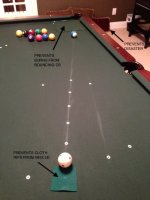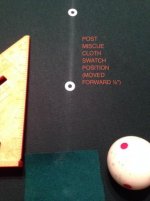A few years ago I came across an August 1991 article from Billiards Digest by Dr. George Onoda titled "Avoiding Miscues on Draw Shots". It's available on Bob Jewett's web site (item 31): http://www.sfbilliards.com/miscellaneous.htm
Dr. Onoda stated that the cause of miscues on draw shots was that the cue tip contacts the table surface and bounces up into the cue ball. It's not because you didn't chalk enough or your tip needs scuffing. It made sense to me but I had no empirical evidence. Until now!
This week I've been practicing distance draw shots. I started with the CB near the center of the table and attempted to pocket the OB and draw the CB back to the end rail. Once proficient at that I backed the CB up a donut and repeat. Finally I start with the CB on the foot spot.
Two things have further proven to me that draw miscues are caused by a bouncing tip:
1) Before I got smart, I put three small rips in my cloth from miscues while practicing this drill
2) After each miscue the green protective cloth swatch has moved forward a half inch or more, pushed by the cue tip bouncing off it.
Dr. Onoda stated that the cause of miscues on draw shots was that the cue tip contacts the table surface and bounces up into the cue ball. It's not because you didn't chalk enough or your tip needs scuffing. It made sense to me but I had no empirical evidence. Until now!
This week I've been practicing distance draw shots. I started with the CB near the center of the table and attempted to pocket the OB and draw the CB back to the end rail. Once proficient at that I backed the CB up a donut and repeat. Finally I start with the CB on the foot spot.
Two things have further proven to me that draw miscues are caused by a bouncing tip:
1) Before I got smart, I put three small rips in my cloth from miscues while practicing this drill
2) After each miscue the green protective cloth swatch has moved forward a half inch or more, pushed by the cue tip bouncing off it.


